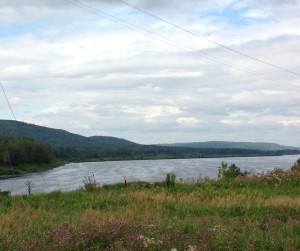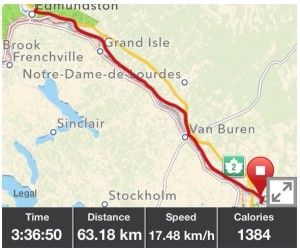Edmundston to Grand Falls/Grand-Sault
We rode down the hill from our hotel for espresso at Presse Café and then onto the transCanada (Highway 2). We had considered taking an alternate route, but it is longer and we were unsure as to the hard shoulder and hills. After a few kilometres we were overtaken by a local older cyclist. After passing us on a long incline, he swung back and suggested we might want to take Highway 144 instead, as it was less hilly and more pleasant, at least to Grand Falls. His advice was good and we had a leisurely ride close to the St John River, stopping for lunch at Saint Leonard. In visiting small towns and talking to people we realised that this part of New Brunswick is definitely francophone.
Arriving at Grand-Sault, we stopped to look at the falls, which would be more impressive if the hydro dam had not been built above them in the 1930’s. Of more interest is the history of the town, only one of two in Canada with both French and English names. The community is the most bilingual in Canada with more than 80% of people speaking both official languages. On the road, Acadian flags were again in abundance. Wikipedia has given us some more insight into why. Acadia was a colony of New France consisting of what is today the Maritime Provinces, eastern Quebec, New Brunswick and parts of Maine. As part of the British military campaign against New France in the mid 18th C, the British deported Acadians, first to the Thirteen Colonies and, later, to England and France, from where many migrated to Louisiana. In 1764, Acadians were permitted to return to British territories, provided they took an unqualified oath of allegiance. Under the deportation orders, Acadian land tenure had been forfeited to the British crown and the returning Acadians no longer owned land. The Acadian expulsion was memorialized by Longfellow in his poem, Evangeline. Acadians who lost their land again in New Brunswick to loyalists fleeing the American revolution, apparently made a deal with the Malécite to settle in Madawaska, the region of the upper St John River in New Brunswick and Maine, in exchange for defending the Malécite against further encroachment of their lands.
Wildlife Notes: America Bald Eagles over the St John River.
We remain in the traditional territory of the Malécite People.



